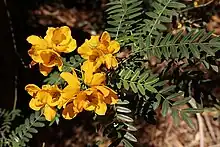Senna barronfieldii
Senna barronfieldii, commonly known as southern cassia,[2] is a species of flowering plant in the family Fabaceae and is endemic to eastern Australia. It is an erect shrub with more or less glabrous, pinnate leaves with eight to thirteen pairs of lance-shaped or elliptic leaflets, and yellow flowers in groups of three to five.
| Southern cassia | |
|---|---|
 | |
| In the Australian National Botanic Gardens | |
| Scientific classification | |
| Kingdom: | Plantae |
| Clade: | Tracheophytes |
| Clade: | Angiosperms |
| Clade: | Eudicots |
| Clade: | Rosids |
| Order: | Fabales |
| Family: | Fabaceae |
| Subfamily: | Caesalpinioideae |
| Genus: | Senna |
| Species: | S. barronfieldii |
| Binomial name | |
| Senna barronfieldii | |
| Synonyms[1] | |
| |
Description
Senna barronfieldii is an erect shrub that typically grows to a height of up to 2.5 m (8 ft 2 in). Its leaves are pinnate, 80–150 mm (3.1–5.9 in) long on a petiole 6–14 mm (0.24–0.55 in) long, with eight to thirteen pairs of lance-shaped or elliptic leaflets 10–30 mm (0.39–1.18 in) long and 5–10 mm (0.20–0.39 in) wide. There is are several stalked glands between each pair of leaflets. The flowers are yellow and arranged in upper leaf axils in groups of three to five on a peduncle 30–90 mm (1.2–3.5 in) long, each flower on a pedicel 10–20 mm (0.39–0.79 in) long. The petals are 12–20 mm (0.47–0.79 in) long and there are ten fertile stamens, the anthers 4–6 mm (0.16–0.24 in) long. Flowering occurs in spring and summer, and the fruit is a more or less flattened pod 80–120 mm (3.1–4.7 in) long.[2][3]
Taxonomy
This species was first formally described in 1826 by Luigi Aloysius Colla who gave it the name Cassia barronfieldii in his Hortus Ripulensis.[4] In 2005, Helen Joan Hewson transferred the species to Senna as Senna barronfieldii in the journal Telopea.[5] The specific epithet (barronfieldii) honours Barron Field.[6]
Distribution and habitat
Senna barronfieldii grows in forest, the edges of rainforest and in subtropical rainforest in eastern Queensland and in eastern New South Wales as far south as Bega.[3][2]
References
- "Senna barronfieldii". Australian Plant Census. Retrieved 4 June 2023.
- "Senna barronfieldii". Australian Biological Resources Study, Department of Agriculture, Water and the Environment: Canberra. Retrieved 4 June 2023.
- Wiecek, Barbara. "Senna barronfieldii". Royal Botanic Garden Sydney. Retrieved 4 June 2023.
- "Cassia barronfieldii". Australian Plant Name Index. Retrieved 4 June 2023.
- "Senna barronfieldii". Australian Plant Name Index. Retrieved 4 June 2023.
- Hewson, Helen J. (2005). "Justice for Justice Barron Field". Telopea. 11 (1): 96–97. Retrieved 4 June 2023.